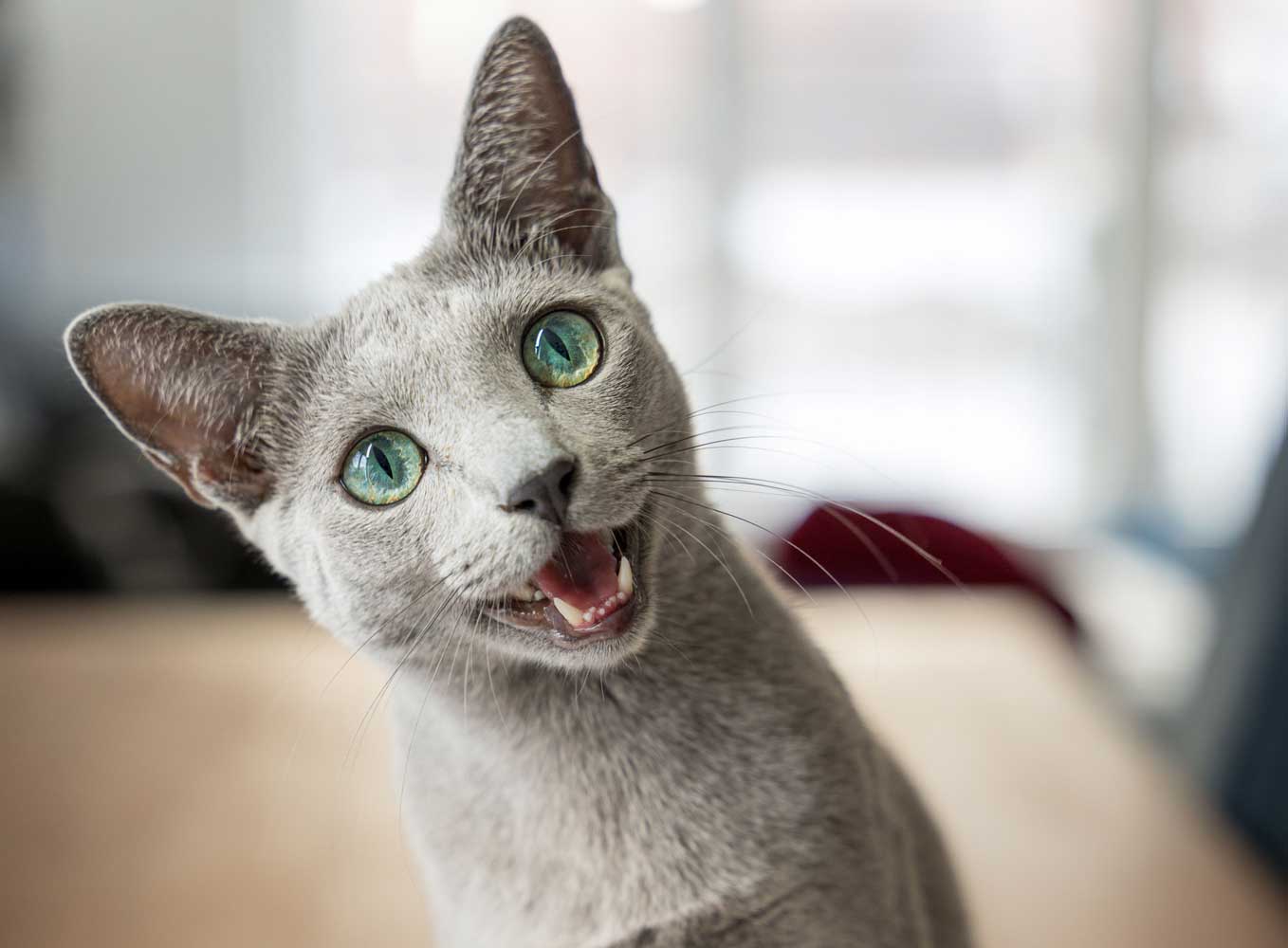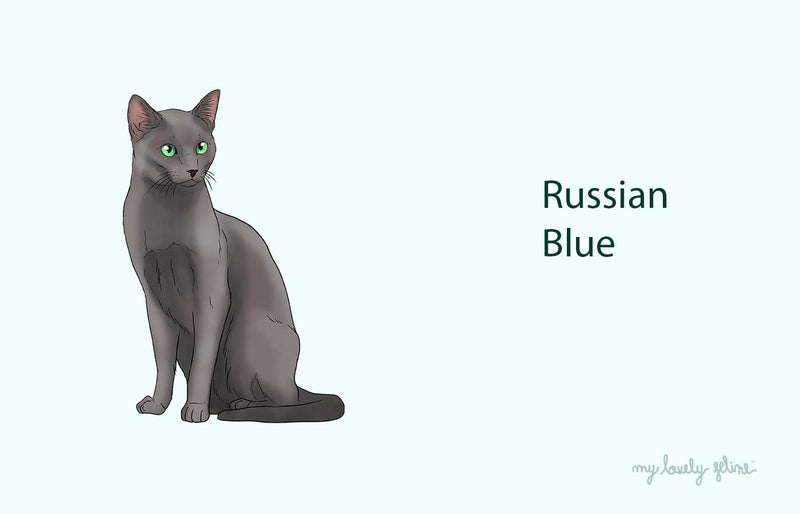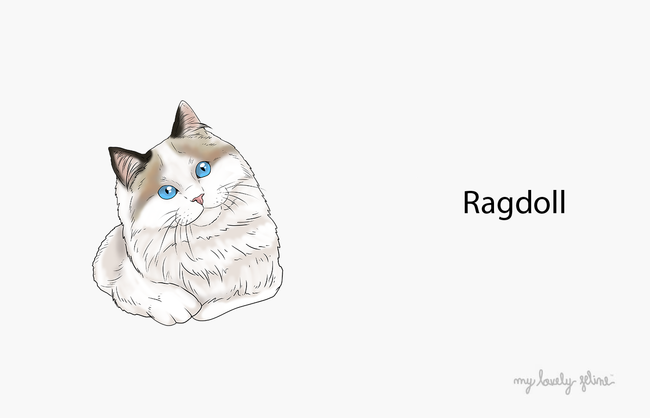|
Welcome to the enchanting world of the Russian Blue cat, where elegance and playfulness harmoniously coexist. With their strikingly beautiful silver-blue coat, captivating green eyes, and graceful demeanor, Russian Blues have long been regarded as one of the most stunning cat breeds. But don't let their regal appearance fool you – these feline wonders are also known for their mischievous and playful nature. Whether they are gracefully leaping from one furniture piece to another or engaging in a game of hide-and-seek, Russian Blues are always ready to entertain and bring joy into your life. Beyond their playful antics, these cats are also renowned for their intelligence and loyalty, making them wonderful companions and members of the family. So, if you're looking for a feline friend that not only exudes elegance but also brings endless joy and companionship, the Russian Blue cat is the perfect choice. |
The History and Origin of the Russian Blue
The history of the Russian Blue is shrouded in mystery and intrigue. While it is believed that they originated in Russia, their exact origins remain uncertain. Some theories suggest that Russian Blues were brought to Europe by sailors from the Archangel Isles in Northern Russia.
Others believe that they were the favorite pets of Russian czars and czarinas, who revered them for their elegance and charm. Regardless of their origins, Russian Blues began to gain popularity in the late 19th century, and by the early 20th century, they had made their way to the United States, captivating cat lovers with their unique beauty and playful nature. Today, the Russian Blue is recognized as a distinct breed by cat associations worldwide.
The Russian Blue is known for its striking physical characteristics, which set it apart from other cat breeds. Their most distinguishing feature is their beautiful silver-blue coat, which is dense, silky, and shimmering. This luxurious coat not only adds to their elegance but also enhances their charm.
Their coat is short and plush, requiring minimal grooming to maintain its lustrous appearance. Russian Blues also have captivating green eyes that are often described as "emerald" or "sea-green."
These eyes, combined with their silver-blue coat, give them an enchanting and regal look. In terms of size, Russian Blues are medium-sized cats with a muscular build and a graceful, lithe body. Their legs are long and slender, allowing them to move with agility and grace.

Personality and Temperament of the Russian Blue
The Russian Blue cat's elegant appearance is matched by its delightful personality and temperament. These cats are known for being intelligent, curious, and playful. They have a natural inclination for exploration and love to investigate their surroundings.
You'll often find them gracefully leaping from one furniture piece to another or engaging in a game of chase with a toy mouse. Russian Blues are also highly adaptable and can easily adjust to new environments, making them great companions for individuals and families alike.
Despite their playful nature, Russian Blues are also known for their calm and gentle demeanor. They are not overly demanding or attention-seeking, but rather, they prefer to observe their surroundings with a sense of quiet elegance. Russian Blues are typically reserved around strangers but are incredibly affectionate and loyal with their loved ones.
They form strong bonds with their human companions and are known to follow them around the house, always wanting to be a part of the action. Russian Blues are also known for their excellent communication skills. They have a soft and melodious voice, and they use it to convey their needs and desires to their owners.
Caring for a Russian Blue Cat: Diet and Grooming
Caring for a Russian Blue cat involves providing them with a balanced diet and ensuring their grooming needs are met. Like all cats, Russian Blues require a diet that is appropriate for their age, size, and activity level. It is recommended to feed them high-quality cat food that is rich in protein and essential nutrients.
Consult with your veterinarian to determine the appropriate portion sizes and feeding schedule for your Russian Blue. It is also important to provide them with fresh water at all times and to monitor their weight to prevent obesity.
In terms of grooming, Russian Blues have a short coat that is relatively low-maintenance. However, regular brushing is still necessary to keep their coat in optimal condition. Brushing helps remove loose hair, prevents matting, and stimulates blood circulation.
Additionally, it is advisable to trim their nails regularly to prevent them from becoming too long or sharp. Dental hygiene is also crucial for Russian Blues, so regular teeth brushing or providing dental treats can help maintain their oral health.
Training and Socialization Tips for Russian Blue Cats
Russian Blues are highly intelligent cats that can be trained to perform tricks and commands. They are quick learners and respond well to positive reinforcement techniques. Use treats, praise, and playtime as rewards when training your Russian Blue.
Start with basic commands such as sit, stay, and come, and gradually progress to more advanced tricks. Russian Blues also enjoy interactive toys and puzzle games that stimulate their minds and keep them entertained.
Socialization is equally important for Russian Blue cats. Introduce them to various people, animals, and environments from an early age to help them become well-adjusted and confident adults. Expose them to different sounds, sights, and experiences to ensure they develop into sociable and outgoing cats. Encourage positive interactions with other pets and provide opportunities for play and exploration.
Health Concerns and Common Issues in Russian Blue Cats
Russian Blue cats are generally healthy and robust, but like all breeds, they may be predisposed to certain health issues. It is essential to be aware of these potential concerns and to work closely with your veterinarian to ensure your Russian Blue receives proper care and preventive measures.
One common health issue in Russian Blues is hypertrophic cardiomyopathy (HCM), a heart condition that can lead to heart failure. Regular check-ups and screenings can help detect any early signs of cardiac abnormalities. Another condition to be aware of is obesity, as Russian Blues can be prone to weight gain if not provided with a balanced diet and regular exercise. Monitor your cat's weight and consult with your veterinarian to develop a suitable diet and exercise plan.
Russian Blue Cat Breeders and Adoption Options
If you are interested in adding a Russian Blue cat to your family, there are several options available. You can choose to adopt from a local animal shelter or rescue organization. Many purebred cats, including Russian Blues, end up in shelters and are in need of loving homes. Adoption is a wonderful way to give a cat a second chance and provide them with a forever home.
Alternatively, you can also opt to purchase a Russian Blue kitten from a reputable breeder. When choosing a breeder, ensure they adhere to ethical breeding practices and prioritize the health and well-being of their cats. A responsible breeder will provide you with all the necessary documentation, such as health certificates and pedigrees, and allow you to visit their facility to meet the kittens and their parents.
Fun Facts about Russian Blue Cats
- Russian Blues are often referred to as the "Doberman Pinschers of the cat world" due to their sleek and elegant appearance.
- These cats have been featured in various works of literature and art throughout history, symbolizing elegance, grace, and mystery.
- Russian Blues are considered hypoallergenic because they produce fewer allergenic proteins than other cat breeds, making them a great choice for individuals with allergies.
- These cats are excellent jumpers and climbers, thanks to their agile and athletic nature.
- Russian Blues have a unique coat texture that feels like plush velvet when touched.
Debunking the Myth: Do Russian Blue Cats With Long Hair Exist?
Debunking the Myth: Contrary to popular belief, Russian Blue cats with long hair do not exist within the breed. The misconception may have arisen due to occasional variations or mix-breeding that result in cats resembling the Russian Blue but possessing long hair.
However, such cats are not recognized as authentic Russian Blue cats by reputable cat associations.
Confusion with Other Breeds: The confusion surrounding Russian Blue cats with long hair may also stem from their resemblance to other long-haired breeds.
For instance, the Nebelung breed, which emerged from the Russian Blue breed, shares similar characteristics but possesses a semi-long, shimmery coat. It is crucial to differentiate between these breeds to avoid misrepresentation and misidentification.
Russian Blue Cat FAQ
What is a Russian Blue cat?
A Russian Blue cat is a distinct breed known for its striking appearance, dense short coat, and mesmerizing green eyes. They are renowned for their gentle and affectionate nature.
What does a Russian Blue cat look like?
Russian Blue cats have a medium-sized, muscular body with a graceful posture. They have a short, dense double coat that is silver-blue in color, giving them an elegant and shimmering appearance. Their eyes are usually vivid green.
Are Russian Blue cats hypoallergenic?
Russian Blue cats are often considered hypoallergenic or less allergenic compared to other cat breeds. While no cat breed is completely hypoallergenic, Russian Blues produce fewer allergenic proteins, which may make them more suitable for individuals with allergies.
What is the temperament of Russian Blue cats?
Russian Blue cats are known for their gentle and reserved temperament. They are generally calm, intelligent, and affectionate cats that form strong bonds with their human companions. They tend to be quiet and observant, enjoying a peaceful environment.
Are Russian Blue cats good with children and other pets?
Russian Blue cats are usually good with children and other pets. They are patient and tolerant, making them suitable companions for families. Proper introductions and gentle interactions are important to ensure positive relationships with children and other animals.
How active are Russian Blue cats?
Russian Blue cats are moderately active. While they enjoy playtime and interactive toys, they are not hyperactive cats. They appreciate having their own quiet spaces and can entertain themselves when needed.
Do Russian Blue cats require a lot of grooming?
Russian Blue cats have a short and dense coat that requires minimal grooming. Weekly brushing is generally sufficient to remove loose hairs and keep their coat in good condition. They are known for self-grooming and keeping themselves tidy.
What is the lifespan of a Russian Blue cat?
Russian Blue cats have a relatively long lifespan, typically ranging from 12 to 16 years. With proper care, nutrition, and regular veterinary check-ups, some Russian Blues can live even longer.
Are Russian Blue cats indoor or outdoor cats?
Russian Blue cats are primarily indoor cats. Their dense coat and reserved nature make them more suited to indoor living. Keeping them indoors protects them from potential dangers such as traffic, predators, and infectious diseases.
Are Russian Blue cats vocal?
Russian Blue cats are generally not excessively vocal. They may communicate with soft chirps, trills, or meows, but they are known for their quiet and gentle nature.
Are Russian Blue cats prone to any specific health issues?
Russian Blue cats are generally considered a healthy breed with no specific breed-related health issues. However, as with any cat, they can be susceptible to common feline health problems such as obesity, dental issues, and certain genetic conditions. Regular veterinary check-ups are important to ensure their well-being.
Can Russian Blue cats be left alone for long periods?
Russian Blue cats are independent and can tolerate being left alone for moderate periods. However, they still require companionship and interaction. If left alone for extended periods, providing them with environmental enrichment, interactive toys, and a stimulating environment can help prevent boredom.
How can I find a reputable Russian Blue breeder?
To find a reputable Russian Blue breeder, it is recommended to do thorough research, seek recommendations from trusted sources, and contact established cat associations or clubs that can provide a list of registered breeders. Meeting the breeder in person and asking questions about their breeding practices and the health of their cats is also important.
Are Russian Blue cats high-maintenance in terms of care?
Russian Blue cats are generally low-maintenance in terms of grooming. Their short coat requires minimal brushing. They are independent cats and can entertain themselves to some extent. However, they still require regular feeding, playtime, and social interaction for their well-being.
Can Russian Blue cats adapt to different living environments?
Russian Blue cats are adaptable and can adjust to different living environments, including apartments or houses. As long as they receive proper care, attention, and a stimulating environment, they can thrive in various living situations.
Hydration
Hydration plays a crucial role in maintaining the well-being and health of Russian Blue cats, just as it does for us humans. As a proud owner of a Russian Blue, it is vital to understand the importance of ensuring your feline companion stays adequately hydrated.
Russian Blue cats have a reputation for being somewhat finicky when it comes to drinking water. They may not show the same enthusiasm for water bowls as some other breeds. This unique behavior can make it challenging to ensure they consume enough fluids to support their overall hydration levels.
Proper hydration is essential for several reasons. Firstly, water is a vital component in maintaining the overall functioning of a cat's body. Adequate hydration supports the optimal functioning of vital organs, aids digestion, and helps regulate body temperature. Without sufficient water intake, cats, including our beloved Russian Blues, can experience a range of health issues.
One particular concern for Russian Blue cats is their predisposition to developing urinary tract problems, such as urinary tract infections or crystal formations. These issues can be exacerbated by inadequate hydration, as concentrated urine can lead to the formation of crystals or stones. By encouraging your Russian Blue to drink more water, you help dilute their urine and reduce the likelihood of these issues arising.
Dehydration can also negatively impact a cat's coat and skin condition. As Russian Blues are renowned for their luxurious, dense coat, ensuring they have proper hydration can help maintain the lustrous appearance of their fur and prevent dryness or matting.
To encourage your Russian Blue to drink more water, there are several strategies you can employ. Providing fresh and clean water in multiple locations throughout your home is a good start. Some cats prefer running water, so investing in a cat water fountain can entice them to drink more frequently. Ensuring the water is refreshed regularly, preferably daily, will help maintain its freshness and appeal.
Adding wet food to your Russian Blue's diet is another effective way to increase their water intake. Wet food has a higher moisture content compared to dry kibble, contributing to their overall hydration. Additionally, you can consider incorporating water-rich treats or using a syringe or water dropper to offer water directly if your Russian Blue shows a particular aversion to drinking.
Monitoring your Russian Blue's water intake and observing signs of dehydration are crucial responsibilities as a cat owner. Symptoms of dehydration may include dry gums, loss of skin elasticity, sunken eyes, lethargy, or reduced appetite. If you suspect your Russian Blue is dehydrated or experiencing any health concerns, consulting with a veterinarian is always recommended.
Remember, maintaining proper hydration for your Russian Blue cat is a vital aspect of their care. By providing access to clean water, promoting water consumption through various methods, and being vigilant about their hydration levels, you can help ensure your Russian Blue remains healthy, happy, and well-hydrated for years to come.
Conclusion: Is a Russian Blue Cat the Right Pet for You?
In conclusion, the Russian Blue cat is a perfect blend of elegance and playfulness. With their striking silver-blue coat, captivating green eyes, and graceful demeanor, they are truly a sight to behold.
Beyond their regal appearance, Russian Blues are intelligent, loyal, and affectionate companions. They are known for their playful nature and mischievous antics, always ready to bring joy and entertainment into your life.
With proper care, a balanced diet, and regular grooming, Russian Blues can thrive and live a happy and healthy life. Whether you choose to adopt or purchase a Russian Blue, you are sure to find a devoted and loving companion that will bring endless joy and companionship into your home.
So, if you're looking for a feline friend that exudes elegance and playfulness, the Russian Blue cat is the perfect choice for you.




